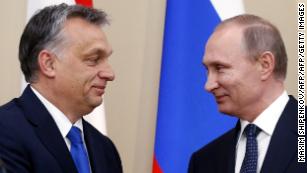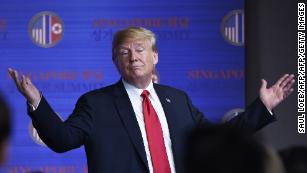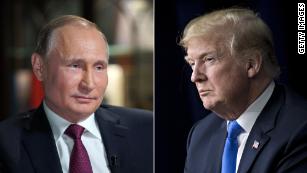By Mark Hertling
Retired Lt. Gen. Mark Hertling is a national security, intelligence and terrorism analyst for CNN. He served for 37 years in the Army, including three years in combat, and retired as commanding general of US Army Europe and the 7th Army. He is the author of "Growing Physician Leaders." The opinions expressed in this commentary are his own. (CNN)On July 11 and 12, NATO members will come together for their first summit since meeting in Warsaw in 2016. They were primed to discuss the strategic direction of the alliance and ambitious subjects like enhancing capabilities to fight terrorism, addressing cyber and hybrid attacks on national institutions, building a greater Black Sea presence, and further strengthening the transatlantic bond.
Unfortunately, President Donald Trump's announced meeting with Russian President Vladimir Putin, his continued trashing of the NATO alliance, and recent calls for a reassessment of US force posture on the European continent have undercut the planned NATO agenda and will likely take the air out of the room in Brussels, Belgium.
During the late 19th and 20th centuries, there were at least six major wars on the European continent, including two World Wars. Tens of millions died. Since the NATO alliance was formed, there have been minor skirmishes — Bosnia, Kosovo, others — but no major wars.
Simply put, NATO is the architecture of a Europe whole, free and at peace -- and the United States is the steel of that architecture. While President Trump is right when he says the NATO joint commitments to our collective defense must evolve, doing so without a vision of transformation is poor leadership and a missed opportunity.
NATO grew from 14 to 29 nations after the dissolution of the Soviet Union in 1989. The newest members — mostly former eastern bloc countries — sought stability, security and freedom from the Russian sphere of influence. Joining NATO was the best strategic measure available to them to allay the continued fear of Russian interference in their sovereignty — and potentially a return of Russian forces to their territory — and it gave them the growing opportunity to enhance their national defense capabilities by seamlessly working with other members of the alliance.
US forces in Europe have a motto
With the recent attention on North Korea, many Americans were reminded of the mantra of US and Republic of Korea forces on the peninsula: "Prepare to fight tonight." The American forces in Europe also have a motto: "Stronger together." Those forces continuously build trust and maintain the NATO partnerships (and add security to areas outside the European continent) because they are "an ocean closer" to major contingencies in Africa, the Middle East and Europe that might occur. Belonging to NATO provides significant strategic opportunities for the United States.
The US presence in Europe gives our military far greater flexibility for global operations that defend American interests from within that NATO alliance, and we gain significantly from being a part of that group of like-minded nations.
Defining how we address this realignment is critical. It's easy to dismiss the alliance as a 20th century relic: This ignores that it remains the essential core of our 21st century security needs in a new era of great-power politics underlaid by hybrid threats -- the kinds of things addressed in President Trump's recently published National Security Strategy. But our allies fear that he intends to counter his own strategy while disrupting this proven alliance when it may be needed most.
 It is now confirmed that the President will meet with Russian President Vladimir Putin a few days after the NATO summit. Since Russia's annexation of Crimea, Russia has launched asymmetric attacks into the sovereign territory of eastern Ukraine, provided the missile and the air defense system that shot down a civilian passenger jet over the eastern region of Ukraine, has partnered with Syrian leader Bashar al-Assad as he has used chemical weapons and bombed hospitals in Syria, and allegedly used a nerve agent to poison Sergei Skripal in the United Kingdom — just a few of the Kremlin actions that have caused the united NATO members to focus sanctions and wrath on Russia.
It is now confirmed that the President will meet with Russian President Vladimir Putin a few days after the NATO summit. Since Russia's annexation of Crimea, Russia has launched asymmetric attacks into the sovereign territory of eastern Ukraine, provided the missile and the air defense system that shot down a civilian passenger jet over the eastern region of Ukraine, has partnered with Syrian leader Bashar al-Assad as he has used chemical weapons and bombed hospitals in Syria, and allegedly used a nerve agent to poison Sergei Skripal in the United Kingdom — just a few of the Kremlin actions that have caused the united NATO members to focus sanctions and wrath on Russia.
It's not by accident that most of the summit agenda addresses methods to counter the Kremlin's adventurism. Trump's pursuit of a post-game meeting with the Russian President is rightfully seen by members of the alliance as counter to the core collective security goals of the organization.
This is doubly true when the President says, "NATO is as bad as NAFTA" and then followed up by sending letters to eight NATO members berating them about not meeting the 2% of GDP defense spending target. Germany, Italy, Spain, Portugal, Luxembourg, Norway, Belgium, and the Netherlands received his notes. These public diplomatic affronts — seen as motivated by domestic political talking points — will continue to disrupt the members who are actively contributing to military missions alongside the United States. Our contributions as allies need to be better balanced, and Germany needs to step up. But shifting security requirements should mean new ways of determining what these contributions include.
Finally, there is new reporting that President Trump was "taken aback" by the size of the US presence in Germany and asked for an analysis of the potential withdrawal or transfer of those forces. This has caused anxiety in Washington and in European capitals alike. While the Pentagon continuously reviews the number of deployed and stationed US forces everywhere in the world, the timing of this particular release concerning the number of US forces in Germany prior to the NATO summit was unfortunate.
American forces in Europe are mostly positioned in Germany because that is where they "stopped" at the end of World War II. European Command Headquarters is in Stuttgart, US Army Europe was in Heidelberg but is now consolidated in Wiesbaden, US Air Force Europe is at Ramstein (near Frankfurt), and now the new US Africa Command (AFRICOM) is also in Germany, placed there for a variety of force protection and efficiency reasons.
 During the Cold War, the United States had over 250,000 soldiers in Europe, most in Germany. In 1989, when the Berlin Wall fell and the United States realized the potential for a peace dividend with the Russian Federation, the heavy and conventional US forces had plans to withdraw by the mid-'90s. Desert Storm and the fighting in Bosnia and Kosovo delayed that action, because most of the US forces fighting to liberate Kuwait and conduct peacekeeping operations in the former Yugoslavia were those deployed from within Europe.
During the Cold War, the United States had over 250,000 soldiers in Europe, most in Germany. In 1989, when the Berlin Wall fell and the United States realized the potential for a peace dividend with the Russian Federation, the heavy and conventional US forces had plans to withdraw by the mid-'90s. Desert Storm and the fighting in Bosnia and Kosovo delayed that action, because most of the US forces fighting to liberate Kuwait and conduct peacekeeping operations in the former Yugoslavia were those deployed from within Europe.
Nonetheless, by the end of the century, the massive Cold War contingent was drawn down to about 90,000. In 2003, Secretary of Defense Donald Rumsfeld gave the European Command commanding general another order to further reduce those forces to "about" 35,000 between 2003-2011. The Army and the Air Force would do that, consolidating into five major bases in Germany.
The mission has changed
The mission of the US military forces in Europe, like NATO, has changed since the end of the Cold War, addressing a wider range of global threats. Counterterrorism, intelligence operations, cybersecurity, countering human and terrorist trafficking, noncombatant evacuation operations, engagement and training with allies and partners for participation in out-of-theater operations, security and peacekeeping operations, national guard partnership programs, and a variety of other "engagement" missions are run from Europe.
The United States maintains critical facilities in Germany, sized to meet the missions. One key function coordinates intelligence with most of our partners, especially on issues like terrorism and trafficking. The military training center at Grafenwoehr, once a US Army facility, is now a place where all allied militaries train together so they can fight together like they did in Iraq, Afghanistan, Syria and multiple African countries.
 Landstuhl Hospital, the military's only Level III trauma hospital outside the United States, also serves as a transfer point for military and diplomatic personnel in Europe, Africa and the Middle East. Tens of thousands of wounded went through Landstuhl from combat zones to stabilize before returning to the United States. There are many large logistics units that contribute to the continuing mission in Europe but are also positioned in Europe for current operations in other areas (like support to our troops in Afghanistan and peacekeeping operations in the Balkans and Middle East) and future contingencies that might involve port openings, movement of massive amounts of supplies, and intermodal operations.
Landstuhl Hospital, the military's only Level III trauma hospital outside the United States, also serves as a transfer point for military and diplomatic personnel in Europe, Africa and the Middle East. Tens of thousands of wounded went through Landstuhl from combat zones to stabilize before returning to the United States. There are many large logistics units that contribute to the continuing mission in Europe but are also positioned in Europe for current operations in other areas (like support to our troops in Afghanistan and peacekeeping operations in the Balkans and Middle East) and future contingencies that might involve port openings, movement of massive amounts of supplies, and intermodal operations.
There is also the Marshall Center, an educational facility that has contributed to the development of ranking military officials and high-ranking government officials from Europe, Africa, Middle East and beyond. Finally, we keep two combat brigades in Europe, each with about 6,000 soldiers that conduct training, exercises and operations with those 49 countries in Europe and the Levant, along with a large Army Aviation unit in Germany that provides airlift support for not only soldiers but also any US official (Congress, President, etc.) traveling in the theater.
All in all, it isn't a large footprint. Having served in Europe for a big part of my career and having commanded US Army forces there from 2011-2013 — in the midst of both the "reset" and President Obama's "pivot to Asia" — I can say that the mission is instrumental to the Alliance's strength and viability.
That's especially true now in the face of Russian expansionism and threatening actions. NATO remains the best bet for keeping threats from American shores, and it also contributes to building the transformed alliances that will face the new threats of the 21st century.
Follow CNN Opinion
In many ways, Putin has acted to counter the influence of NATO, disrupt Western alliances and Western institutions, defeat the economic community of Europe, and return to the Russia of old. A continuously evolving and strong NATO prevents him from achieving his goals. But NATO needs to be more than a shield to hold the army of the Russian bear at bay. It must transform into a new fabric of capabilities and deterrence designed to repel hybrid and non-state threats.
The upcoming meetings may set the course for the future of the West, and for the strength — or weakness — of the United States for the remainder of the century.
No comments:
Post a Comment